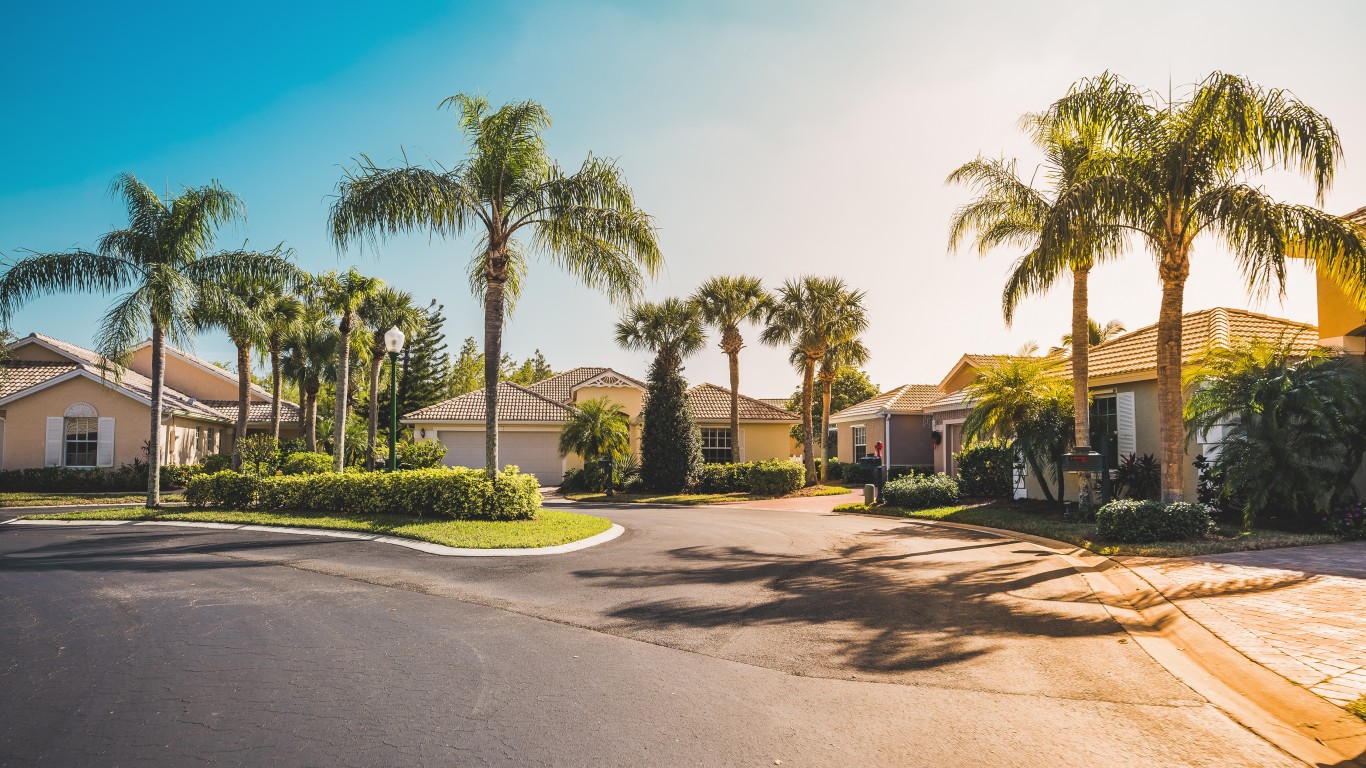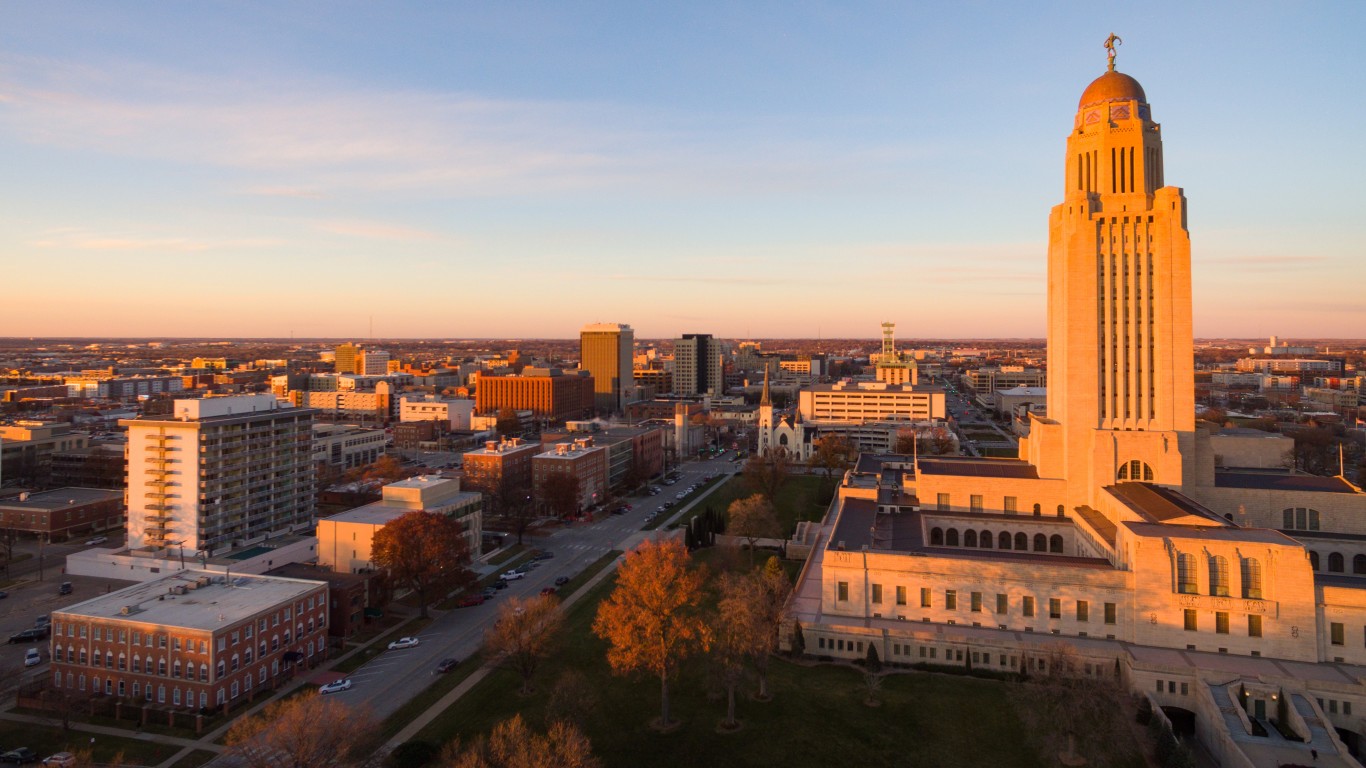
In March, the U.S. senate voted down a provision to the COVID-19 relief bill to increase the U.S. minimum wage to $15 an hour. The proposed increase was meant to correct the relative declining value of the current $7.25 minimum that has been in place for more than a decade, lift millions of working Americans out of poverty conditions — which were exacerbated by the COVID-19 recession — and strengthen the middle class.
The American middle class — once a major source of pride in the United States — has changed considerably over the course of recent decades. While the United States remains one of the most prosperous countries in the world, rising income inequality has generated more debate on how resources are distributed in general and to the middle class in particular.
One way to examine the American middle class is to look at where middle-income earners are residing and how the geographic concentration of the nation’s economic majority has changed.
The median income of the wealthiest fifth of U.S. households increased by 36.7% from 2008 to 2018. Income of the middle fifth of households meanwhile grew by just 26.8%, and income of the bottom fifth grew at half the pace of the top half — or just 18.1%.
Partially as a result, the share of income earned by the upper quintile of households increased slightly, from 49.5% of all U.S. income in 2010 to 49.7% in 2019. Over the same period, the share of the earnings of middle class households fell from 14.6% of all income to 14.3%. In the vast majority of states, the middle class share of income fell — in some far more than others.
To determine the states where the middle class is disappearing, 24/7 Wall St. reviewed the decline in the share of aggregate household income earned by the middle quintile of households in all 50 states from 2010 to 2019 with data from the U.S. Census Bureau’s American Community Survey.
Click here to see the states where the middle class is being left behind.
Click here to see our methodology.

50. Rhode Island
> Chg. in middle class income share (2010-2019): +0.3 ppts.
> Middle class share of income: 15.0% (2010), 15.3% (2019)
> Richest 20% of residents’ share of income: 49.7% (2010), 49.5% (2019)
> Poorest 20% of residents’ share of income: 3.1% (2010), 3.2% (2019)
[in-text-ad]

49. Alabama
> Chg. in middle class income share (2010-2019): +0.1 ppts.
> Middle class share of income: 14.5% (2010), 14.6% (2019)
> Richest 20% of residents’ share of income: 50.5% (2010), 50.5% (2019)
> Poorest 20% of residents’ share of income: 3.2% (2010), 3.1% (2019)

48. South Dakota
> Chg. in middle class income share (2010-2019): +0.1 ppts.
> Middle class share of income: 15.4% (2010), 15.5% (2019)
> Richest 20% of residents’ share of income: 47.7% (2010), 47.6% (2019)
> Poorest 20% of residents’ share of income: 3.8% (2010), 4.0% (2019)

47. Colorado
> Chg. in middle class income share (2010-2019): +0.0 ppts.
> Middle class share of income: 15.0% (2010), 15.0% (2019)
> Richest 20% of residents’ share of income: 49.2% (2010), 49.3% (2019)
> Poorest 20% of residents’ share of income: 3.4% (2010), 3.6% (2019)
[in-text-ad-2]

46. Oregon
> Chg. in middle class income share (2010-2019): +0.0 ppts.
> Middle class share of income: 15.2% (2010), 15.2% (2019)
> Richest 20% of residents’ share of income: 48.5% (2010), 48.6% (2019)
> Poorest 20% of residents’ share of income: 3.6% (2010), 3.5% (2019)

45. Kentucky
> Chg. in middle class income share (2010-2019): -0.1 ppts.
> Middle class share of income: 14.7% (2010), 14.6% (2019)
> Richest 20% of residents’ share of income: 49.8% (2010), 50.8% (2019)
> Poorest 20% of residents’ share of income: 3.4% (2010), 3.2% (2019)
[in-text-ad]

44. New Mexico
> Chg. in middle class income share (2010-2019): -0.1 ppts.
> Middle class share of income: 14.7% (2010), 14.6% (2019)
> Richest 20% of residents’ share of income: 49.7% (2010), 50.8% (2019)
> Poorest 20% of residents’ share of income: 3.3% (2010), 3.1% (2019)

43. Idaho
> Chg. in middle class income share (2010-2019): -0.1 ppts.
> Middle class share of income: 15.6% (2010), 15.5% (2019)
> Richest 20% of residents’ share of income: 47.3% (2010), 47.6% (2019)
> Poorest 20% of residents’ share of income: 3.9% (2010), 4.1% (2019)

42. Kansas
> Chg. in middle class income share (2010-2019): -0.1 ppts.
> Middle class share of income: 15.3% (2010), 15.2% (2019)
> Richest 20% of residents’ share of income: 48.2% (2010), 48.9% (2019)
> Poorest 20% of residents’ share of income: 3.7% (2010), 3.7% (2019)
[in-text-ad-2]

41. Missouri
> Chg. in middle class income share (2010-2019): -0.2 ppts.
> Middle class share of income: 15.0% (2010), 14.8% (2019)
> Richest 20% of residents’ share of income: 49.1% (2010), 49.9% (2019)
> Poorest 20% of residents’ share of income: 3.5% (2010), 3.4% (2019)

40. Vermont
> Chg. in middle class income share (2010-2019): -0.2 ppts.
> Middle class share of income: 15.5% (2010), 15.3% (2019)
> Richest 20% of residents’ share of income: 48.0% (2010), 48.4% (2019)
> Poorest 20% of residents’ share of income: 3.7% (2010), 3.6% (2019)
[in-text-ad]

39. Arizona
> Chg. in middle class income share (2010-2019): -0.2 ppts.
> Middle class share of income: 15.0% (2010), 14.8% (2019)
> Richest 20% of residents’ share of income: 49.2% (2010), 49.7% (2019)
> Poorest 20% of residents’ share of income: 3.5% (2010), 3.5% (2019)

38. Wisconsin
> Chg. in middle class income share (2010-2019): -0.2 ppts.
> Middle class share of income: 15.7% (2010), 15.5% (2019)
> Richest 20% of residents’ share of income: 46.9% (2010), 47.8% (2019)
> Poorest 20% of residents’ share of income: 4.0% (2010), 3.9% (2019)

37. Minnesota
> Chg. in middle class income share (2010-2019): -0.2 ppts.
> Middle class share of income: 15.6% (2010), 15.4% (2019)
> Richest 20% of residents’ share of income: 47.7% (2010), 48.2% (2019)
> Poorest 20% of residents’ share of income: 3.8% (2010), 3.7% (2019)
[in-text-ad-2]

36. Texas
> Chg. in middle class income share (2010-2019): -0.2 ppts.
> Middle class share of income: 14.6% (2010), 14.4% (2019)
> Richest 20% of residents’ share of income: 50.4% (2010), 51.0% (2019)
> Poorest 20% of residents’ share of income: 3.3% (2010), 3.3% (2019)

35. Massachusetts
> Chg. in middle class income share (2010-2019): -0.2 ppts.
> Middle class share of income: 14.9% (2010), 14.7% (2019)
> Richest 20% of residents’ share of income: 50.3% (2010), 50.9% (2019)
> Poorest 20% of residents’ share of income: 2.9% (2010), 2.8% (2019)
[in-text-ad]

34. West Virginia
> Chg. in middle class income share (2010-2019): -0.3 ppts.
> Middle class share of income: 15.1% (2010), 14.8% (2019)
> Richest 20% of residents’ share of income: 48.4% (2010), 49.6% (2019)
> Poorest 20% of residents’ share of income: 3.6% (2010), 3.2% (2019)

33. Florida
> Chg. in middle class income share (2010-2019): -0.3 ppts.
> Middle class share of income: 14.4% (2010), 14.1% (2019)
> Richest 20% of residents’ share of income: 51.0% (2010), 51.8% (2019)
> Poorest 20% of residents’ share of income: 3.4% (2010), 3.4% (2019)

32. Delaware
> Chg. in middle class income share (2010-2019): -0.3 ppts.
> Middle class share of income: 15.5% (2010), 15.2% (2019)
> Richest 20% of residents’ share of income: 47.6% (2010), 48.7% (2019)
> Poorest 20% of residents’ share of income: 3.7% (2010), 3.5% (2019)
[in-text-ad-2]

31. Maryland
> Chg. in middle class income share (2010-2019): -0.3 ppts.
> Middle class share of income: 15.5% (2010), 15.2% (2019)
> Richest 20% of residents’ share of income: 47.9% (2010), 49.1% (2019)
> Poorest 20% of residents’ share of income: 3.5% (2010), 3.3% (2019)

30. Utah
> Chg. in middle class income share (2010-2019): -0.3 ppts.
> Middle class share of income: 16.0% (2010), 15.7% (2019)
> Richest 20% of residents’ share of income: 46.1% (2010), 47.1% (2019)
> Poorest 20% of residents’ share of income: 4.2% (2010), 4.2% (2019)
[in-text-ad]

29. Hawaii
> Chg. in middle class income share (2010-2019): -0.3 ppts.
> Middle class share of income: 16.0% (2010), 15.7% (2019)
> Richest 20% of residents’ share of income: 46.7% (2010), 47.5% (2019)
> Poorest 20% of residents’ share of income: 3.6% (2010), 3.5% (2019)

28. Tennessee
> Chg. in middle class income share (2010-2019): -0.3 ppts.
> Middle class share of income: 14.7% (2010), 14.4% (2019)
> Richest 20% of residents’ share of income: 50.2% (2010), 51.1% (2019)
> Poorest 20% of residents’ share of income: 3.3% (2010), 3.4% (2019)

27. Virginia
> Chg. in middle class income share (2010-2019): -0.3 ppts.
> Middle class share of income: 14.9% (2010), 14.6% (2019)
> Richest 20% of residents’ share of income: 49.4% (2010), 50.5% (2019)
> Poorest 20% of residents’ share of income: 3.4% (2010), 3.3% (2019)
[in-text-ad-2]

26. Nebraska
> Chg. in middle class income share (2010-2019): -0.3 ppts.
> Middle class share of income: 15.7% (2010), 15.4% (2019)
> Richest 20% of residents’ share of income: 47.0% (2010), 48.0% (2019)
> Poorest 20% of residents’ share of income: 4.0% (2010), 3.9% (2019)

25. Arkansas
> Chg. in middle class income share (2010-2019): -0.3 ppts.
> Middle class share of income: 14.7% (2010), 14.4% (2019)
> Richest 20% of residents’ share of income: 49.5% (2010), 51.0% (2019)
> Poorest 20% of residents’ share of income: 3.6% (2010), 3.4% (2019)
[in-text-ad]

24. Ohio
> Chg. in middle class income share (2010-2019): -0.3 ppts.
> Middle class share of income: 15.1% (2010), 14.8% (2019)
> Richest 20% of residents’ share of income: 48.7% (2010), 50.1% (2019)
> Poorest 20% of residents’ share of income: 3.5% (2010), 3.4% (2019)

23. Illinois
> Chg. in middle class income share (2010-2019): -0.3 ppts.
> Middle class share of income: 14.8% (2010), 14.5% (2019)
> Richest 20% of residents’ share of income: 49.9% (2010), 51.2% (2019)
> Poorest 20% of residents’ share of income: 3.4% (2010), 3.1% (2019)

22. Wyoming
> Chg. in middle class income share (2010-2019): -0.3 ppts.
> Middle class share of income: 16.2% (2010), 15.9% (2019)
> Richest 20% of residents’ share of income: 46.0% (2010), 47.2% (2019)
> Poorest 20% of residents’ share of income: 3.9% (2010), 3.7% (2019)
[in-text-ad-2]

21. Pennsylvania
> Chg. in middle class income share (2010-2019): -0.3 ppts.
> Middle class share of income: 14.9% (2010), 14.6% (2019)
> Richest 20% of residents’ share of income: 49.5% (2010), 50.9% (2019)
> Poorest 20% of residents’ share of income: 3.4% (2010), 3.3% (2019)

20. New York
> Chg. in middle class income share (2010-2019): -0.4 ppts.
> Middle class share of income: 13.9% (2010), 13.5% (2019)
> Richest 20% of residents’ share of income: 52.9% (2010), 54.4% (2019)
> Poorest 20% of residents’ share of income: 2.9% (2010), 2.5% (2019)
[in-text-ad]

19. New Hampshire
> Chg. in middle class income share (2010-2019): -0.4 ppts.
> Middle class share of income: 15.8% (2010), 15.4% (2019)
> Richest 20% of residents’ share of income: 46.6% (2010), 48.0% (2019)
> Poorest 20% of residents’ share of income: 4.0% (2010), 3.8% (2019)

18. California
> Chg. in middle class income share (2010-2019): -0.4 ppts.
> Middle class share of income: 14.6% (2010), 14.2% (2019)
> Richest 20% of residents’ share of income: 50.5% (2010), 52.0% (2019)
> Poorest 20% of residents’ share of income: 3.2% (2010), 3.0% (2019)

17. Georgia
> Chg. in middle class income share (2010-2019): -0.4 ppts.
> Middle class share of income: 14.8% (2010), 14.4% (2019)
> Richest 20% of residents’ share of income: 50.1% (2010), 51.4% (2019)
> Poorest 20% of residents’ share of income: 3.2% (2010), 3.2% (2019)
[in-text-ad-2]

16. Iowa
> Chg. in middle class income share (2010-2019): -0.4 ppts.
> Middle class share of income: 15.8% (2010), 15.4% (2019)
> Richest 20% of residents’ share of income: 46.7% (2010), 48.1% (2019)
> Poorest 20% of residents’ share of income: 4.1% (2010), 3.8% (2019)

15. North Carolina
> Chg. in middle class income share (2010-2019): -0.4 ppts.
> Middle class share of income: 14.8% (2010), 14.4% (2019)
> Richest 20% of residents’ share of income: 50.0% (2010), 51.0% (2019)
> Poorest 20% of residents’ share of income: 3.4% (2010), 3.3% (2019)
[in-text-ad]

14. Montana
> Chg. in middle class income share (2010-2019): -0.4 ppts.
> Middle class share of income: 15.3% (2010), 14.9% (2019)
> Richest 20% of residents’ share of income: 47.5% (2010), 49.6% (2019)
> Poorest 20% of residents’ share of income: 4.1% (2010), 3.6% (2019)

13. Indiana
> Chg. in middle class income share (2010-2019): -0.4 ppts.
> Middle class share of income: 15.3% (2010), 14.9% (2019)
> Richest 20% of residents’ share of income: 47.8% (2010), 49.5% (2019)
> Poorest 20% of residents’ share of income: 3.8% (2010), 3.6% (2019)
12. Louisiana
> Chg. in middle class income share (2010-2019): -0.4 ppts.
> Middle class share of income: 14.5% (2010), 14.1% (2019)
> Richest 20% of residents’ share of income: 50.5% (2010), 52.3% (2019)
> Poorest 20% of residents’ share of income: 3.2% (2010), 2.6% (2019)
[in-text-ad-2]

11. New Jersey
> Chg. in middle class income share (2010-2019): -0.4 ppts.
> Middle class share of income: 14.9% (2010), 14.5% (2019)
> Richest 20% of residents’ share of income: 49.7% (2010), 51.2% (2019)
> Poorest 20% of residents’ share of income: 3.3% (2010), 3.1% (2019)

10. Michigan
> Chg. in middle class income share (2010-2019): -0.4 ppts.
> Middle class share of income: 15.2% (2010), 14.8% (2019)
> Richest 20% of residents’ share of income: 48.6% (2010), 50.0% (2019)
> Poorest 20% of residents’ share of income: 3.5% (2010), 3.5% (2019)
[in-text-ad]

9. Maine
> Chg. in middle class income share (2010-2019): -0.5 ppts.
> Middle class share of income: 15.6% (2010), 15.1% (2019)
> Richest 20% of residents’ share of income: 47.4% (2010), 48.7% (2019)
> Poorest 20% of residents’ share of income: 3.9% (2010), 3.8% (2019)

8. Mississippi
> Chg. in middle class income share (2010-2019): -0.5 ppts.
> Middle class share of income: 14.6% (2010), 14.1% (2019)
> Richest 20% of residents’ share of income: 49.9% (2010), 52.0% (2019)
> Poorest 20% of residents’ share of income: 3.3% (2010), 3.0% (2019)

7. Oklahoma
> Chg. in middle class income share (2010-2019): -0.5 ppts.
> Middle class share of income: 15.0% (2010), 14.5% (2019)
> Richest 20% of residents’ share of income: 49.1% (2010), 50.9% (2019)
> Poorest 20% of residents’ share of income: 3.6% (2010), 3.3% (2019)
[in-text-ad-2]

6. South Carolina
> Chg. in middle class income share (2010-2019): -0.5 ppts.
> Middle class share of income: 15.0% (2010), 14.5% (2019)
> Richest 20% of residents’ share of income: 49.4% (2010), 50.9% (2019)
> Poorest 20% of residents’ share of income: 3.4% (2010), 3.2% (2019)

5. Connecticut
> Chg. in middle class income share (2010-2019): -0.5 ppts.
> Middle class share of income: 14.3% (2010), 13.8% (2019)
> Richest 20% of residents’ share of income: 51.9% (2010), 53.4% (2019)
> Poorest 20% of residents’ share of income: 3.1% (2010), 2.8% (2019)
[in-text-ad]

4. Alaska
> Chg. in middle class income share (2010-2019): -0.6 ppts.
> Middle class share of income: 16.0% (2010), 15.4% (2019)
> Richest 20% of residents’ share of income: 45.9% (2010), 47.6% (2019)
> Poorest 20% of residents’ share of income: 4.0% (2010), 3.7% (2019)

3. Nevada
> Chg. in middle class income share (2010-2019): -0.6 ppts.
> Middle class share of income: 15.3% (2010), 14.7% (2019)
> Richest 20% of residents’ share of income: 48.4% (2010), 50.6% (2019)
> Poorest 20% of residents’ share of income: 3.7% (2010), 3.3% (2019)

2. Washington
> Chg. in middle class income share (2010-2019): -0.7 ppts.
> Middle class share of income: 15.6% (2010), 14.9% (2019)
> Richest 20% of residents’ share of income: 47.7% (2010), 49.6% (2019)
> Poorest 20% of residents’ share of income: 3.7% (2010), 3.5% (2019)
[in-text-ad-2]

1. North Dakota
> Chg. in middle class income share (2010-2019): -0.8 ppts.
> Middle class share of income: 15.9% (2010), 15.1% (2019)
> Richest 20% of residents’ share of income: 46.8% (2010), 49.1% (2019)
> Poorest 20% of residents’ share of income: 3.8% (2010), 3.5% (2019)
Methodology:
To determine the states where the middle class is disappearing, 24/7 Wall St. reviewed the percentage-point decline in the share of aggregate household income earned by the middle quintile of households in all 50 states from 2010 to 2019, using data from the U.S. Census Bureau’s American Community Survey. We defined the middle class as the third income quintile, or the middle 20% of households. Because ACS income data reflects pre-tax levels, the figures may overstate the degree of income inequality in the poorer quintiles. However, it is unlikely that the tax burden of the third quintile is significant enough to skew the data. Additional data on the Gini index of income inequality came from the ACS.
Take This Retirement Quiz To Get Matched With An Advisor Now (Sponsored)
Are you ready for retirement? Planning for retirement can be overwhelming, that’s why it could be a good idea to speak to a fiduciary financial advisor about your goals today.
Start by taking this retirement quiz right here from SmartAsset that will match you with up to 3 financial advisors that serve your area and beyond in 5 minutes. Smart Asset is now matching over 50,000 people a month.
Click here now to get started.
Thank you for reading! Have some feedback for us?
Contact the 24/7 Wall St. editorial team.
 24/7 Wall St.
24/7 Wall St. 24/7 Wall St.
24/7 Wall St. 24/7 Wall St.
24/7 Wall St. 24/7 Wall St.
24/7 Wall St.

